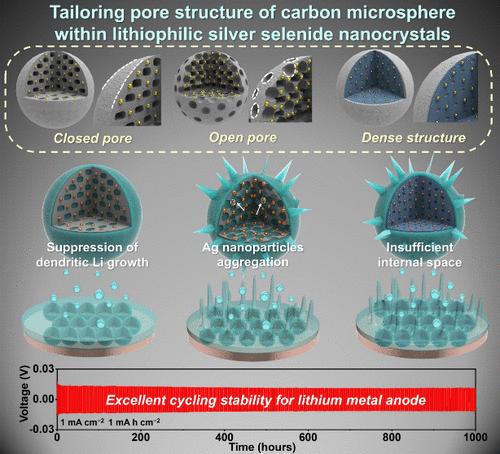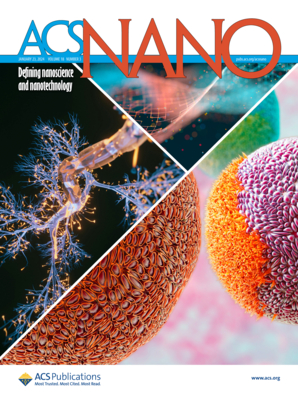Novel Lithiophilic Silver Selenide Nanocrystals within Porous Carbon Microsphere: Tailoring Pore Structures for Enhanced Lithium Metal Battery Anodes
IF 15.8
1区 材料科学
Q1 CHEMISTRY, MULTIDISCIPLINARY
引用次数: 0
Abstract
To enable the practical use of a lithium metal anode, the rational design of three-dimensional (3D) host materials is considered as a promising approach to mitigate lithium dendrite formation and accommodate substantial volume fluctuations. Herein, we first design a 3D conductive host material comprised of Ag2Se nanocrystals encapsulated within closed pore structured porous carbon microspheres. The homogeneous distribution of the AgLi alloy and Li2Se phases, generated through the consecutive conversion and alloying reaction of the Ag2Se phase, enables the developed host materials to exhibit rapid lithium deposition kinetics. Additionally, the inner void structures with encapsulated lithiophilic nanocrystals promote primary deposition within the carbon framework without dendrite growth. Consequently, optimized pore structure as well as position of lithiophilic nanocrystals in carbon microsphere are rationally tailored for stable plating/stripping behaviors of lithium with high Coulombic efficiency and stable voltage profiles. Paired with the LiNi0.8Co0.1Mn0.1O2 cathode, the assembled full cell demonstrates outstanding cycling stability and impressive high-rate performance, highlighting its potential for practical applications. Moreover, to explore how different pore structures influence the stability of the Li metal host, Ag2Se@C hosts with various pore structures (including open pore structures and densely structured configurations without inner voids) are also fabricated and compared with the developed host material.

为了实现锂金属负极的实际应用,合理设计三维(3D)宿主材料被认为是一种很有前途的方法,可以减少锂枝晶的形成并适应巨大的体积波动。在这里,我们首先设计了一种三维导电宿主材料,由封装在封闭孔结构多孔碳微球中的 Ag2Se 纳米晶体组成。通过 Ag2Se 相的连续转换和合金化反应生成的 AgLi 合金相和 Li2Se 相的均匀分布,使所开发的宿主材料表现出快速的锂沉积动力学。此外,封装有亲锂纳米晶体的内部空隙结构促进了碳框架内的一次沉积,而不会产生枝晶生长。因此,优化的孔隙结构以及亲锂纳米晶体在碳微球中的位置都是为实现稳定的锂镀层/剥离行为、高库仑效率和稳定的电压曲线而合理定制的。与锂镍0.8Co0.1Mn0.1O2正极搭配,组装后的全电池表现出卓越的循环稳定性和令人印象深刻的高倍率性能,突显了其实际应用的潜力。此外,为了探索不同孔隙结构如何影响锂金属宿主的稳定性,还制作了具有不同孔隙结构(包括开放孔隙结构和无内部空隙的致密结构配置)的 Ag2Se@C 宿主,并与所开发的宿主材料进行了比较。
本文章由计算机程序翻译,如有差异,请以英文原文为准。
求助全文
约1分钟内获得全文
求助全文
来源期刊

ACS Nano
工程技术-材料科学:综合
CiteScore
26.00
自引率
4.10%
发文量
1627
审稿时长
1.7 months
期刊介绍:
ACS Nano, published monthly, serves as an international forum for comprehensive articles on nanoscience and nanotechnology research at the intersections of chemistry, biology, materials science, physics, and engineering. The journal fosters communication among scientists in these communities, facilitating collaboration, new research opportunities, and advancements through discoveries. ACS Nano covers synthesis, assembly, characterization, theory, and simulation of nanostructures, nanobiotechnology, nanofabrication, methods and tools for nanoscience and nanotechnology, and self- and directed-assembly. Alongside original research articles, it offers thorough reviews, perspectives on cutting-edge research, and discussions envisioning the future of nanoscience and nanotechnology.
 求助内容:
求助内容: 应助结果提醒方式:
应助结果提醒方式:


